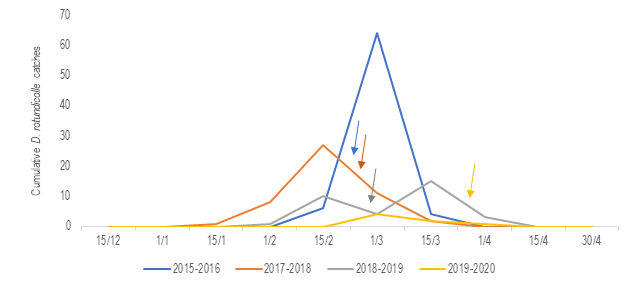Monitoring and study of bio-ecological aspects of the citrus borer, Diploschema rotundicolle (Coleoptera:Cerambycidae), in southern-Uruguay lemon orchards
DOI:
https://doi.org/10.31285/AGRO.26.1064Keywords:
integrated pest management, light traps, Cerambycid beetles, Neotropical CerambycinaeAbstract
The citrus borer, Diploschema rotundicolle, is a South American cerambycid beetle considered a primary citrus pest in Uruguay. Serious focalized population explosions have been registered in recent years, particularly in lemon orchards. The larvae feed on the woody tissue, causing tree deterioration and reducing grove productivity and value. Current management relies on cultural control, which is expensive and ineffective partially because of imprecise timing of interventions. Monitoring tools for adults or information of their flight periods in Uruguay are not available thus far. Working in lemon groves in southern Uruguay throughout four flight seasons (2015-2020), we used cross-vane traps coupled with white light devices to capture night-flying adults, and mesh covers around infested trees to study adult emergence. Visual observation of larval activity and oviposition damage were also performed throughout the year. Finally, Eucalyptus globulus windbreaks were checked underneath loosen barks for hidden adults. Throughout all four seasons, adult flight occurred between late January and early April, with a maximum around mid-February. Emergence from mesh-covered trees was observed in the same period. In general, oviposition damage was observed closely after the peak of adult catches. Mostly females were both trapped in light traps and emerged from infested trees. Larval activity was registered all year long. Adults were found sheltered under E. globulus barks; in this case, mostly individual males or couples were found. This study provides a monitoring tool for D. rotundicolle adult flight and information on bio-ecological aspects of this pest in southern Uruguay.
Downloads
References
Bentancourt CM, Scatoni IB. Guía de insectos y ácaros de importancia agrícola y forestal en el Uruguay. 3a ed. Montevideo: Facultad de Agronomía; 2010. 582p.
Biezanko CM, Bosq JM. Cerambycidade de Pelotas e seus arrededores. Agros. 1956;9(3-4):3-16.
Faria AM, Fernandes SCS, dos Santos JCC, Bergmann E, Brisolla AD, Takematsu AD, Negri JD, Sempinoato OR. Estudo sobre controle da brocados ramos e do tronco dos citros Diploschema rotundicolle (Serville, 1834) (Coleoptera - Cerambycidae). O Biológico. 1987;53(1-6):13-8.
Horton DR. Monitoring of pear psylla for pest management decisions and research. Integrated Pest Manag Rev. 1999;4:1-20.
Link D, Corrêa Costa E. Nível de infestação da broca dos citros, Diploschema rotundicolle (serville, 1834) em cinamomo e plantas cítricas, em Santa Maria - RS. Cienc Rural. 1994;24(1):7-10.
Machado LA, Berti Filho EB. Prática cultural associada ao controle biológico com o fungo Metarhizium anisopliae no combate à broca-dos-citros Diploschema rotundicolle. Arq Inst Biol. 2006;73(4):439-45.
Machado LA, Cruz BPB, Leite LG, Batista Filho A, da Silva EM. Praticas para o controle da broca dos citros, Diploschema rotundicolle, (Serville, 1834) (Coleoptera-Cerambycidae). In: XIII Congresso Brasileiro de Entomologia; 1991; Recife, Brasil. Recife: Editora Raiz; 1991. p. 366.
Machado LA, Filho B. Criação artificial da brocados-citros Diploschema rotundicolle (Serville, 1834) (Col.: Cerambycidae). O Biológico. 1999;61(11):5-11.
Shanley RP, Keena M, Wheeler MM, Leland J, Hajek AE. Evaluating the virulence and longevity of non-woven fiber bands impregnated with Metarhizium anisopliae against the Asian longhorned beetle, Anoplophora glabripennis (Coleoptera: Cerambycidae). Biol Control. 2009;50:94-102.

Published
How to Cite
Issue
Section
License
Copyright (c) 2022 Agrociencia Uruguay

This work is licensed under a Creative Commons Attribution 4.0 International License.
| Article metrics | |
|---|---|
| Abstract views | |
| Galley vies | |
| PDF Views | |
| HTML views | |
| Other views | |















